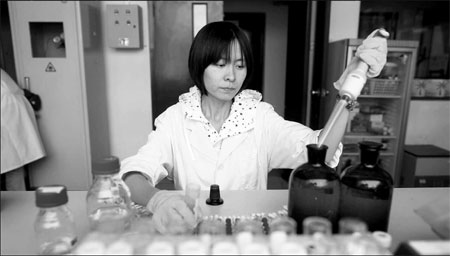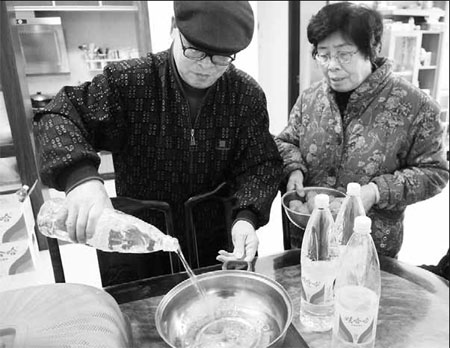New testing of safer water challenged
Updated: 2012-05-24 08:09
By Wu Wencong and Zheng Jinran (China Daily)
|
||||||||
|
A staff member from Beijing Waterworks Group tests a water sample before it flows to the pipeline. New quality standards for drinking water will come into effect on July 1. Provided to China Daily |
|
Wei Shubing (left) and his wife must use bottled water for cooking after Longjiang River was contaminated by cadmium in January, affecting residents of Liuzhou city in the Guangxi Zhuang autonomous region. Provided to China Daily |

New standards will improve quality but concerns still remain, report Wu Wencong and Zheng Jinran.
New standards for drinking water will come into force in China on July 1, with the number of quality indicators rising to 106 from 35. While that's almost on par with standards used in the European Union, some experts have raised concerns about the feasibility of the new system.
"There are about 3,000 water companies in China," said Li Fuxing, director of the Beijing Institute of Public Health and Drinking Water.
"Judging by their production technology and quality-testing facilities, most still have a long way to go before they can meet the new standards."
Meanwhile, Fu Tao, director of Tsinghua University's Water Policy Research Center, said that the number of cities with facilities to test all 106 indicators covers a very small portion of the area served by the industry.
Under the reforms, first released in 2006, all treatment plants are obliged to meet the new criteria by July 1 this year. Some cities, such as Beijing, quickly achieved that goal, but despite the five-year hiatus, many companies have yet to upgrade their equipment or production techniques. "By the end of 2009, 98 percent of China's water plants were still employing production processes that have been in use for decades," Lan Weiguang, adjunct associate professor from the chemistry department of the National University of Singapore, wrote in his micro blog.
Meanwhile, the number of indicators to test for organic compounds in drinking water will rise to 53 from just five. "That means the government has realized the importance of controlling organic pollutants," said Lan. "But most water plants fail to meet the target because of outdated production processes."
Some experts have asked why it's taken so long for the new regulations to come into force. "Other countries may use fewer indicators than us, but they are strictly implemented as soon as they're released. We have waited five years for these standards to be enforced," said Li. "Also, in many countries, the standards are revised annually, based on various data," he added, noting that, before 2006, the last revision in China was back in 1985.
The 2006 reforms unified the water quality standards in the country's rural and urban areas for the first time. But even as plants in the city struggle to meet the new criteria, those in rural areas face an even tougher challenge because their quality standards have always lagged behind.
Take quality monitoring in the rural areas of the southwestern province of Sichuan as an example. Work didn't begin until 2004, and official statistics show that only 20 indicators were being measured by 2011, nowhere near the 1985 standard of 35, to say nothing of the 106 stipulated by the 2006 reforms.
Despite this, Sichuan is seen as something of a role model in the improvement of water quality, having undertaken a large number of projects to provide safe drinking water to its rural population, which is geographically dispersed over vast distances, with many people living in inaccessible mountainous regions. Meanwhile, the situation in provinces such as Yunnan and Guizhou is much worse.
Traditional treatment
Traditionally, the treatment process consists of four steps: flocculation, precipitation, filtration and chlorination. The first three remove particle pollutants and reduce the water's turbidity, making it clearer to the eye, while the addition of chlorine kills micro-organisms.
Chlorination is seen as one of the major innovations of the 20th century, but in 1977 scientists in the United States discovered that organic compounds left in the water after the first three steps in the treatment process may react with chlorine to generate potentially carcinogenic byproducts.
Meanwhile, the issue of water safety has been in the spotlight recently after a report in Century Weekly magazine this month quoted unnamed industry insiders who said only about 50 percent of the water in urban areas actually meets the required standards.
A second body blow was delivered by Dong Liangjie, an expert in heavy metal pollution in water and a former researcher at the University of Hawaii. Quoting a paper recently published in a scientific journal, Dong claimed that researchers have found contaminants in all 23 water testing areas that, under certain conditions, can produce effects similar to contraceptives.
Meanwhile, other experts said that, given the severely polluted state of the source water and the ineffectual treatment processes, less than 50 percent of the nation's tap water reaches the required standards.
In response, officials from several areas went on record to say that tap water is safe to drink, in their provinces at least. The figures they released were all higher than 95 percent, much higher than the Century Weekly report.
Four days after the report was published, Shao Yi-sheng, director of the monitoring center of the Ministry of Housing and Urban-Rural Development, released the latest official safety figures: 83 percent. Shao cited a survey conducted by the ministry in 2011, but didn't reveal the locations of the 17 percent that failed to meet national standards.
"The water quality in cities such as Beijing and Shanghai is relatively stable, but for residents of small cities, 50 percent or 83 percent doesn't really mean anything."
Netizens were dissatisfied with Shao's figures and asked for more information, including the locations where water quality failed to meet the standards. They also wanted to know what measures have been taken to rectify the situation, but the ministry has turned down requests for interviews on the topic.
Source water quality
The safety of tap water is dependent on many factors, the most important being the quality of source water, according to experts. The latest figure, released by the Ministry of Water Resources, said 80 percent is safe nationally. But Century Weekly quoted Song Lanhe, another official from the ministry's monitoring center, as saying that the rate is actually closer to 50 percent.
"Much of China's source water is now surrounded by residential buildings, especially farms," said Tsinghua University's Fu. "The increase in annual agricultural output is supported by the use of huge amounts of chemicals and fertilizers, which will definitely enter the water table and contaminate our source water."
Meanwhile, sewage dumped into rivers by chemical plants has also played a major role in changing the main pollutants from micro-organisms to organic compounds and heavy metals, many of which are toxic. "The facilities and equipment currently used in water plants were able to remove source-water pollutants efficiently before the 1980s, but they can't deal with those we face now," said Li.
The nation's antiquated pipeline network is another thorn in the side of those seeking to improve the quality of the water supply. Statistics released by the China Institute of Water Resources and Hydropower Research suggest that approximately 6 percent of the pipes have been in use for more than 50 years. "The water quality decreases by about 10 percent during this (delivery) process," said Wang Hao, head of the water resources department at the institute, according to a recent report from the Xinhua News Agency.
"The levels of bacteria in the pipes increase tenfold every decade. Some corrosive substances in the pipes may also be absorbed by the water," said Zhao Feihong, a researcher at the Beijing Institute of Public Health and Drinking Water. Projects to replace the older pipes are currently ongoing nationwide, but China's vast landmass means the situation will take a long time to rectify.
Other dangers lurk unseen too: To guarantee adequate water pressure, buildings higher than six stories usually utilize a holding tank on the top floor. The system, known as 'gravity feeding" works well, but can become a health hazard if not carefully maintained. "These water tanks usually lack a regular sanitation management regime and are often loosely sealed," commented Lan Weiguang. "Green moss, bacteria and even the bodies of small animals are often found in them."
Low levels of funding
According to insiders from the Ministry of Housing and Urban-Rural Development, the fundamental problem in maintaining water quality is the low level of funding. "Investment is far from sufficient in this sector," they said.
Those insiders received support from a number of experts. The problems inherent in the treatment process, the pipes and water tanks can be solved with the existing technology, they said, but there simply isn't enough money invested in the system to provide that technology.
That problem is compounded by the fact that even raising the water quality indicator by one level results in spiraling treatment costs. Industry insiders told Xinhua that testing all 106 indicators in one sample costs 15,000 to 20,000 yuan ($2,370 to $3,160). However, as all of the indicators must be tested at least once a year, and others on a monthly or weekly basis, that sort of money is beyond most cities at present.
Contact the reporters at wuwencong@chinadaily.com.cn or zhengjinran@chinadaily.com.cn
(China Daily 05/24/2012 page1)

 Relief reaches isolated village
Relief reaches isolated village
 Rainfall poses new threats to quake-hit region
Rainfall poses new threats to quake-hit region
 Funerals begin for Boston bombing victims
Funerals begin for Boston bombing victims
 Quake takeaway from China's Air Force
Quake takeaway from China's Air Force
 Obama celebrates young inventors at science fair
Obama celebrates young inventors at science fair
 Earth Day marked around the world
Earth Day marked around the world
 Volunteer team helping students find sense of normalcy
Volunteer team helping students find sense of normalcy
 Ethnic groups quick to join rescue efforts
Ethnic groups quick to join rescue efforts
Most Viewed
Editor's Picks

|

|

|

|

|

|
Today's Top News
Health new priority for quake zone
Xi meets US top military officer
Japan's boats driven out of Diaoyu
China mulls online shopping legislation
Bird flu death toll rises to 22
Putin appoints new ambassador to China
Japanese ships blocked from Diaoyu Islands
Inspired by Guan, more Chinese pick up golf
US Weekly

|

|








